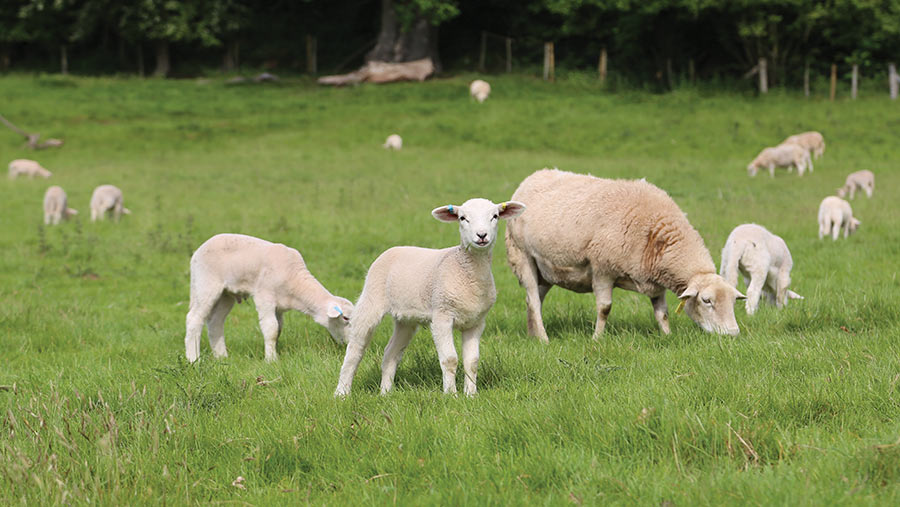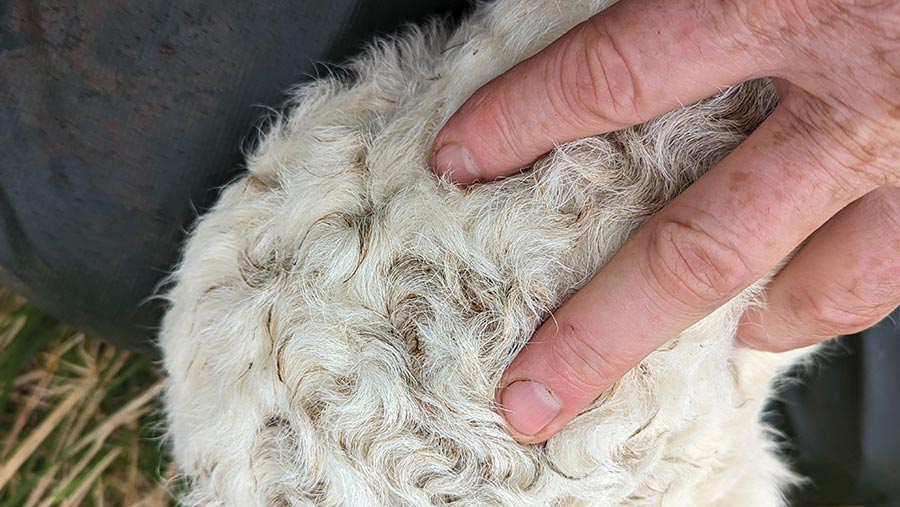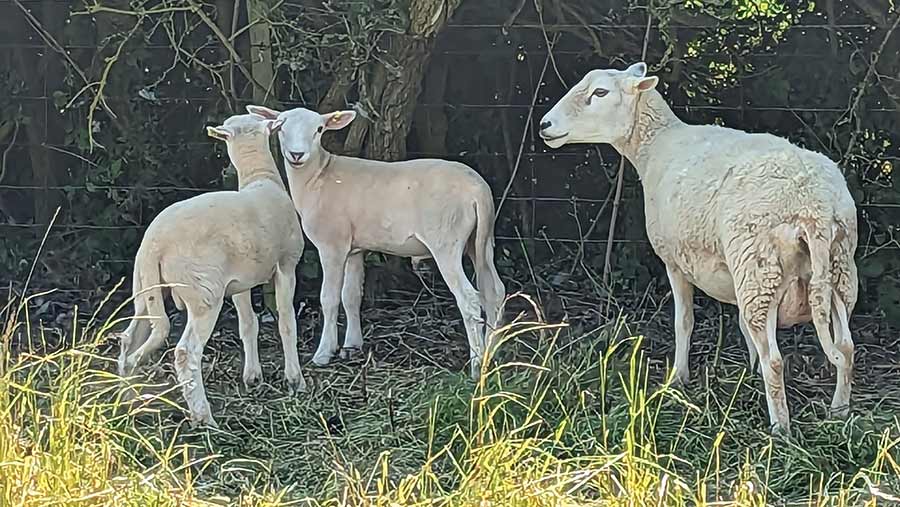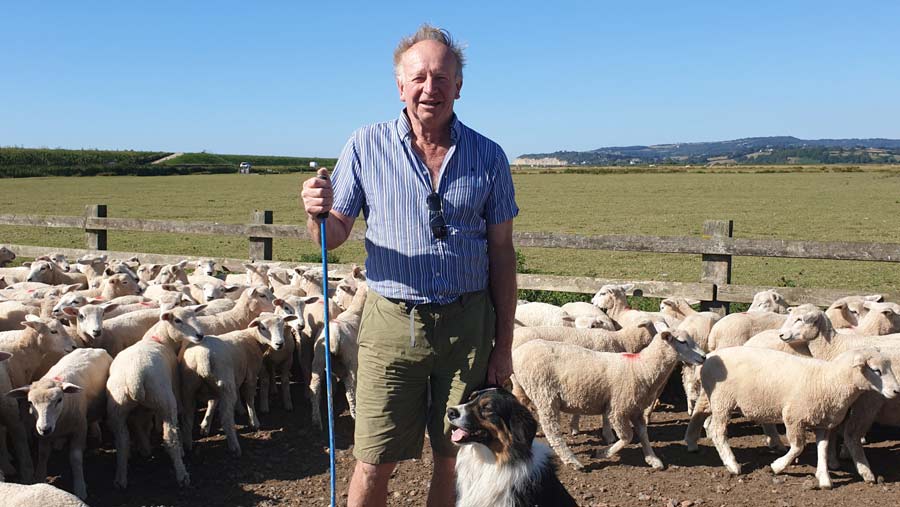Shed v shear: Tackling the wool price challenge
 © Exlana Sheep Improved Genetics Group
© Exlana Sheep Improved Genetics Group Inflationary pressure across farm wages and loss-making wool prices have increased the demand for sheep that shed their fleece.
The British sheep industry has seen growth in crossing to Easycare, Exlana and Wiltshire Horn rams (among others), and the southern hemisphere has recently got in on the action, trying to breed “nudies” with imported British lines of shedders.
With wool being at least 50% carbon, and a sustainable, grass-based means of clothing and insulation, many wonder if wool could one day have a renaissance.
Farmers Weekly spoke to two farmers with different approaches to tackling the wool price challenge and asked the trade about the wool market outlook.
See also: Mixed farm shows how to add value using British wool
Wool markets up
Wool values have recently strengthened by 20% after a few torrid years related to Covid-19 and the inflation-led cost-of-living crisis, says Graham Clark, director of marketing at the British Wool Marketing Board (BWMB).
Wool quality basics

© Exlana Sheep Improved Genetics Group
- Wool quality relates to the diameter of the fibre and is measured in microns. A micron is one millionth of a metre
- At 30 micron and below, wool is no longer ‘scratchy’ and achieves a premium for garments
- Wool from Mules is typically 38-44 micron
- Romney and Cheviot wool is typically low 30s
- Bluefaced Leicesters can be 27-28 micron
- Merino wool is usually 12-25 micron
- A high-quality, 5kg Merino fleece can be worth £25
Graham says the pandemic derailed the market for hard-wearing carpets as casinos, cruise ships and hotels were closed: “Demand from certain retail customers has picked up, and although certain markets are still struggling, contract demand is much improved and demand from China is starting to pick up as well.”
Innovation is key
Finding innovative uses for wool is essential if farmers are to be rewarded, says a merchant sourcing 15-20% of UK wool directly from farmers.
Vincent Pierce, chief executive at Laurence Pierce Wool Merchants (LPWM), has grown this market share with his team from nothing over the past 20 years.
He says the relatively recent production and marketing of sheep wool insulation is “absolutely flying”.
With farm cashflow being tight, he says farmers’ main reason for choosing LPWM over the BWMB is that LPWM pays within a working week, whereas the BWMB takes a year to sell its wool across 20 or more auctions and no longer gives a deposit.
This means farmers can wait for months to be paid for their wool.
Vincent’s assessment of current wool trends is as follows:
- Greater use of shedding flocks could tighten wool supply and support prices, but “critical mass” is more important to dilute all the fixed costs of the wool processing industry
- However, 2023 fleeces are 6-8% lighter, which will tighten supply for the end user
- Urbanisation in China moved more than 300 million people from the countryside into cities between 2013 and 2020, replacing demand for coarse wool with low-micron (finer) wool or finer wool blended with nylon or polypropylene
- As more people move into China’s urban centres with central heating, this will further change the wool market.
What does wool cost?

© Exlana Sheep Improved Genetics Group
One shedding breed – the Exlana – has increased ram sales tenfold since 2015, when 27 rams averaged £705. Last year, 280 rams levelled at £765, mainly through online and private sales.
One of the breed’s founders, Tim White, suggests lowland sheep enterprises need to earn £6.30 for each fleece to reflect the cost of managing sheep with wool (see ‘Cost of wool’ table).
He saw the wool market change after production of synthetic clothing fibres rocketed, and he bred sheep to avoid the labour and cost of wool.
“Shedding isn’t the answer to everything,” says Tim. “You need productive and efficient ewes, and wool can still be a great product.”
Cost of wool
Approximate cost of wool to a lowland flock |
||||||
| Job | £ a ewe | Rate | Number | Gathering days | Labour | Cost (£) |
| Shearing | 1.65 | 1 | 240 | 1 | 120 | 516 |
| Fly strike prevention | 1.07 | 1 | 240 | 0.5 | 60 | 316.18 |
| Dag | 0.73 | 1 | 240 | 0.5 | 60 | 235.20 |
| Lamb flystrike | 1.07 | 1 | 380 | 0.5 | 60 | 445.20 |
| Total (incl labour) | 6.30 | n/a | n/a | 2.5 | 300 | 1,512.58 |
Calculations and assumptions
- A total cost of £1,53342 = £6.39 a ewe (£4.52* plus labour) across a 240-head flock
- Lamb rearing is assumed to be 150%
- Flystrike prevention is one treatment a ewe and one a lamb
Comments
Tim says this cost is conservative, because:
- Some may dose more than once with fly treatments (and some shedding flocks use reduced fly control even in very high-risk areas)
- Some flocks shear twice a year
- More time will be needed to check for flystrike and ewes stuck on their back or in brambles.
Source: Tim White, Exlana
New breed imported for 25-micron wool

Frank Langrish with Romney ewe lambs © Frank Langrish
A Romney Marsh farmer is tired of wool being a cost to his business and has invested in genetics to improve the farm’s wool cheque.
Frank Langrish imported 14 Snowline rams from New Zealand earlier this year.
He believes the composite breed – based on a Romney 25 years ago – is going to leave him with hard-working sheep that produce wool with a lower-micron fleece.
“Last year, the wool cheque was £5,000 and it cost me £15,000 to get them sheared,” explains Frank.
“I thought, I can’t continue like this, and have tried to make better use of the wool.”
Farm facts
Ludley Farm and Castle Farm, Romney Marsh, East Sussex
- 5,000 breeding ewes
- More than 800ha of grass and marshland
- Land all on farm business tenancies
- Supplying 1,000 lambs a year to local butchers
- Lambs sold store and finished through Ashford market
- Sells 500 Romney cross Aberdale ewe lambs a year
Using Snowlines
Frank is collaborating with other interested breeders who are using six Snowlines this season, and Frank kept eight to tup 250 shearlings in autumn 2023.
Shearlings were selected on wool quality: Frank tested the wool at the Wool Testing Authority Europe site at Caernarfon, and the results showed he had 150 females with fleeces below 32 micron.
He helped establish the testing site early on in his 11-year tenure as chairman of the British Wool Marketing Board (BWMB).
Marketing plans
Two high-value clothing outlets are interested in using the wool and are already using Romney wool, for which they pay a small premium.
The wool will still be sold through the BMWB auction system. Frank hopes this market will turn a cost into an income stream.
“If we tried to breed for wool quality in the Romneys, it would probably take us 20 years.
“[Using Snowlines] is hopefully going to see us get down to 25 micron in five years and boost the value of our wool fourfold.”
